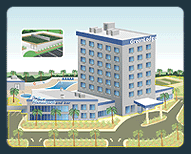|
You should also review these general guidelines and best practices for managing water throughout the hotel.
Landscaping
There are several different water efficient landscape programs. The following landscape methods are designed to promote water conservation:
- Xeriscape
Xeriscaping was one of the first conceptual approaches developed to promote quality landscaping that conserves water and protects the environment. The term was devised by the Denver Water Company to promote water conservation. The seven principles are:· Proper planning and design· Soil analysis and improvement· Appropriate plant selection· Practical turf areas· Efficient irrigation· Use of mulches· Appropriate maintenance
- Water-wise
The Water-wise program has eight principles and is similar to Xeriscaping. The eight principles are:· Group plants according to their water needs· Use native and low-water-use plants· Limit turf areas to those needed for practical uses· Use efficient irrigation systems· Schedule irrigation wisely· Make sure soil is healthy· Remember to mulch· Provide regular maintenance(Water-Efficient Landscaping: Preventing Pollution & Using Resources Wisely, US EPA, Office of Water, EPA832-F-02-002, www.epa.gov/owm/water-efficiency/index.htm)
- Florida Yards and Neighborhoods Program
Developed by the University of Florida Institute of Food and Agricultural Sciences Extension (IFAS Extension) to promote conservation of water and protection of the fragile environment in Florida. Objectives of the Florida Yards and Neighborhoods Program are to:· Reduce stormwater runoff· Decrease non-point source pollution· Conserve water· Enhance wildlife habitat· Create beautiful landscapes(http://hort.ufl.edu/fyn/object.htm)
Major Principles of Florida-friendly Landscaping
- Water efficiently.
A truly efficient way to use water in a yard is to design a landscape that exists predominantly on rainfall. Even with lawn and specialty gardens, it is possible to design it as a Florida Yard. However, even an ideal landscape can be over-watered. It is extremely important to only irrigate to meet the needs of the plants in that area. For example, a lawn in full sun will demand more frequent irrigation than an established plant bed of drought-tolerant shrubs and groundcovers.
- Right plant - right place.
Good landscape design hinges on one basic concept - the right plant in the right place. Careful planning and site evaluation are the first steps in applying this concept.Florida is a diverse state that includes multiple climatic zones. Soil types, temperature ranges and rainfall patterns differ dramatically from region to region. Different conditions often exist in the same property.
- Maximize mulch.
Mulch keeps moisture in the soil, moderates soil temperature and reduces erosion and weeds. Keep a 2-to-3-inch layer of organic mulch over the roots of trees and shrubs and in plant beds. Create self-mulching areas under trees so leaves can stay where they fall. Use by-products or alternative mulches such as pine bark, eucalyptus and melaleuca, or use recycled mulches when available from your community.
- Fertilize appropriately.
Many trees and landscape plants demand little or no fertilizer once they are established and mature. When over-applied, fertilizers aggravate insect and disease problems and force excessive growth, which must be mowed or pruned. Excess fertilizers can run off yards into waterways or leach into the aquifer, polluting drinking water.
- Provide for wildlife.
With more than 1,200 kinds of animals, Florida ranks third in the nation in wildlife diversity. Providing adequate food, water and shelter can increase the number and variety of species that live in your yard.
- Manage yard pests.
It is unrealistic and unwise to strive for an insect-free yard. Many insects are beneficial, helping to keep pests naturally under control. More and more communities and individuals are successfully managing pests by protecting beneficials and reducing the use of pesticides (known as Integrated Pest Management).
- Recycle yard waste.
In a Florida Yard, grass clippings, leaves and yard trimmings are recycled rather than thrown away. By recycling yard debris, we gain free mulch and return valuable nutrients to the soil.
- Reduce stormwater runoff.
Keeping rain and sprinkler water on our yards, and out of storm drains, reduces pollution of our bays, rivers and lakes. Ways to reduce runoff include directing downspouts onto lawns or landscaped beds, using rain barrels to collect rain water for irrigation and using pervious materials such as gravel or mulch for driveways and paths.
- Protect the waterfront.
Bays and waterways make a special contribution to our quality of life, but these natural treasures can also be very fragile. Remove invasive exotic plants and replace with appropriate natives or other non-invasive exotics. Create a 10-foot-to-20-foot "buffer zone" to the shoreline where no chemicals are applied. (http://hillsborough_fyn.ifas.ufl.edu/)
- Select plants that require less water.
Many of these will likely be native plants. An additional benefit to using native plants is that they tend to attract wildlife. Many native plants survive only on rainfall. Native and other "climate appropriate" landscape materials can reduce irrigation water use by more than 50%. (www.eere.energy.gov/femp/techassist/BMP2.html)
- Examples of drought and salt resistant plants.
Trees: Cabbage palm, crape myrtle, live oak, and southern magnolia.
Annuals: Marigold, periwinkle, lantana, and geranium.
Shrubs: Ligustrum, junipers, and American holly.
Ground Covers: Asparagus fern, aloe, day lilies, liriope and English ivy.
Grasses: St. Augustine, Bahia, and Bermuda.
- Choose the right plant for the right place.
Planting the right plant for each location, decreases the amount of water needed. When planning your landscape or garden, select and group plants according to their needs for sunlight and water. Obviously, plants in the full sun will require more water than those in shaded or partially shaded areas.
- Replace mowed landscaping with ground cover.
Plan the landscape with minimal use of grass. Only plant grass that requires watering and mowing where it is necessary for guest satisfaction. Replace grass with ground cover that requires less maintenance and less water. Try to eliminate small areas of grass, such as parking islands and areas between sidewalks and roadways. These are hard to maintain, require a lot of watering and may be replaced with mulch without losing any of the decorative appeal.
- Water efficiently.
Large amounts of water are consumed through watering landscapes. Efficient watering or irrigation practices are essential to conserve water. Over watering not only reduces our water supply but can result in excess water run-off carrying fertilizers and pollutants into our bays, lakes and rivers. It can also result in disease such as fungus and in the excessive growth of weeds and pests. Signs of over watering include dollar weed, root and leaf disease, and thatch buildup. Too much water promotes weak growth and that increases pruning and mowing.Less frequent watering encourages deeper root development and healthier turf. Using chemicals to combat the results of over watering contributes to stormwater runoff and lake and well pollution.
- Use the most efficient irrigations methods.
Use trickle, drip or soaker hose irrigation systems where possible. They use less water than sprinklers. These methods are particularly effective with areas that require more water such as trees or gardens. When sprinklers are used, select one that releases water slowly and close to the ground in contrast to one that releases a mist which tends to evaporate more easily. Place sprinklers at the top of sloped areas so that the water that does run off ends up watering the entire slope. Irrigation heads should be aligned with the areas that they are intended to water.
- Use the best choices for watering.
Sprinklers for Lawns
Bubblers for Trees
Drip Irrigation for Gardens and Shrubs
Soaker Hoses for Flower Beds and Ground Covers
- Don't forget to turn drip or soaker hoses off.
A timer will help eliminate this frequently occurring problem. Irrigation systems also can be metered and set to deliver a specified amount of water. Any new irrigation system is required by law (Chapter 373.62, Florida Statutes) to have a rain shut-off device or sensor that will override the system if sufficient amounts of rain have fallen.
- Check irrigation systems for leaks.
If water drips or leaks from a faucet after being turned off, it could mean that the washer is worn out and needs replacing or the faucet may be broken. The washer can be replaced by the maintenance staff.Use washers between faucets or spigots and water hoses to reduce the loss of water between connections. Also check your hoses for punctures. Repair punctures with duct or electrician's tape or by splicing (connectors can be found at hardware or home supply stores).When using a hand hose to water new plantings, use a nozzle to control the amount of water used.
- Get the most "bang for the buck" when watering.
The best time to water is during the early morning hours when temperatures and wind speeds are at their lowest. Water evaporates quickly in the heat of the day. When it is windy, water may not reach targeted areas or may fall unevenly onto paved areas. If you cannot water in the early morning hours, the next best time to water is in the early evening.
- Check local regulation for watering times.
Become familiar with the watering restrictions in your area. Standard restrictions include no irrigation between 10 a.m. and 4 p.m. There may be additional restrictions in your area, especially during drought conditions. Check with your local water management district and local utility:
St. Johns River Water Management District
http://sjr.state.fl.us/
Northwest Florida Water Management District
http://www.state.fl.us/nwfwmd/
Suwannee River Water Management District
http://www.srwmd.state.fl.us/
Southwest Florida Water Management District
http://www.swfwmd.state.fl.us/
South Florida Water Management District
http://www.sfwmd.gov/
- Check soil before watering.
Before watering, check the soil below the surface. Just because the surface is dry doesn't mean that the roots need water. There may be moisture below the surface. There are tools (such as soil probes or soil sampling tubes) that can be used to obtain soil samples to check for moisture.
- Water the lawn only when needed.
Signs that grass needs watering are: edges of the blades will begin to roll, fold or look wilted; grass will not spring back when you step on it; or the color changes from bright green to dull gray-green or blue.
- Water thoroughly, slowly and less often.
Lawns should be watered so that the soil is moist to a depth of four to six inches. It is better to water your lawn thoroughly (so water reaches the root systems) once each week than to water it lightly each day. Watering lightly could actually harm your lawn because only the surface, rather than the roots, may be reached. Watering should be done slowly to avoid runoff. When the soil has high clay content, it will absorb water slowly. Sandy soil absorbs water quickly but won't retain moisture. Adding organic material will help correct these problems. Spread several inches of mulch, such as wood chips, pine straw or leaves. Shaping the mulch and soil around trees or other large plants into basins will help catch and retain water.
- Fertilize appropriately.
Fertilize in moderation and only during the growing season. Use fertilizers that contain slow-release, water insoluble forms of nitrogen. Better yet, use organic compost.
- Always mulch.
Mulching flower beds, shrub beds and trees has several benefits. It helps the soil absorb water, allows water to better penetrate plants root systems, reduces unwanted weed growth, and insulates plants from changes in temperature. As the mulch decomposes, the organic content of the soil is increased. Mulch also increases the attractiveness of areas.
- Monitor landscape service provider.
Review your landscape service and maintenance agreements to place a high priority on water conservation. Check when irrigation systems are operating to insure they are not watering sidewalks and driveways.
|





